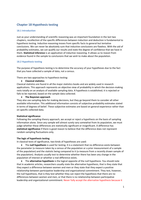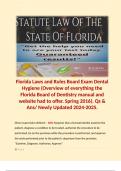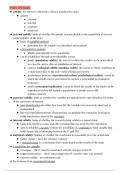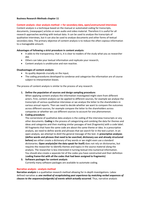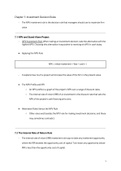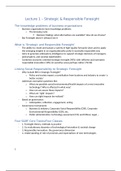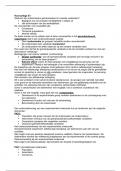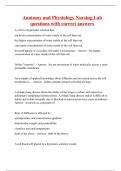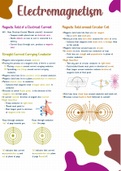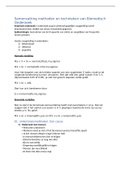Chapter 18 Hypothesis testing
18.1 Introduction
Just as your understanding of scientific reasoning was an important foundation in the last two
chapters, recollection of the specific differences between induction and deduction is fundamental to
hypothesis testing. Inductive reasoning moves from specific facts to general but tentative
conclusions. We can never be absolutely sure that inductive conclusions are flawless. With the aid of
probability estimates, we can qualify our results and state the degree of confidence that we have in
them. Statistical inference is an application of inductive reasoning. It allows us to reason from
evidence found in the sample to conclusions that we wish to make about the population.
18.2 Hypothesis testing
The purpose of hypothesis testing is to determine the accuracy of your hypotheses due to the fact
that you have collected a sample of data, not a census.
There are two approaches to hypothesis testing:
Classical statistics
Classical statistics are found in all the major statistics books and are widely used in research
applications. This approach represents an objective view of probability in which the decision-making
rests totally on an analysis of available sampling data. A hypothesis is established; it is rejected or
fails to be rejected, based on the sample data collected.
The Bayesian approach
They also use sampling data for making decisions, but they go beyond them to consider all other
available information. This additional information consists of subjective probability estimates stated
in terms of degrees of belief. These subjective estimates are based on general experience rather than
on specific collected data.
Statistical significance
Following the sampling-theory approach, we accept or reject a hypothesis on the basis of sampling
information alone. Since any sample will almost surely vary somewhat from its population, we must
judge whether these differences are statistically significant or insignificant. A difference has
statistical significance if there is good reason to believe that the difference does not represent
random sampling fluctuations only.
The logic of hypothesis testing
In classical tests of significance, two kinds of hypotheses are used:
The null hypothesis is used for testing. It is a statement that no difference exists between
the parameter (a measure taken by a census of the population or a prior measurement of a sample
of the population) and the statistic being compared to it (a measure from a recently drawn sample of
the population). Analysts usually test to determine whether there has been any change in the
population of interest or whether a real difference exists.
The alternative hypothesis is the logical opposite of the null hypothesis. You should note
that in academic articles, researchers usually state the alternative hypothesis, that is they state that
they expect a difference between women and men or they state that they expect a positive
relationship between participative leadership and organizational commitment. They test, however,
the null hypothesis, that is they test whether they can reject the hypothesis that there are no
differences between women and men, or that there is no relationship between participative
leadership and organizational commitment. Never fully accept the alternative hypothesis because it
1
18.1 Introduction
Just as your understanding of scientific reasoning was an important foundation in the last two
chapters, recollection of the specific differences between induction and deduction is fundamental to
hypothesis testing. Inductive reasoning moves from specific facts to general but tentative
conclusions. We can never be absolutely sure that inductive conclusions are flawless. With the aid of
probability estimates, we can qualify our results and state the degree of confidence that we have in
them. Statistical inference is an application of inductive reasoning. It allows us to reason from
evidence found in the sample to conclusions that we wish to make about the population.
18.2 Hypothesis testing
The purpose of hypothesis testing is to determine the accuracy of your hypotheses due to the fact
that you have collected a sample of data, not a census.
There are two approaches to hypothesis testing:
Classical statistics
Classical statistics are found in all the major statistics books and are widely used in research
applications. This approach represents an objective view of probability in which the decision-making
rests totally on an analysis of available sampling data. A hypothesis is established; it is rejected or
fails to be rejected, based on the sample data collected.
The Bayesian approach
They also use sampling data for making decisions, but they go beyond them to consider all other
available information. This additional information consists of subjective probability estimates stated
in terms of degrees of belief. These subjective estimates are based on general experience rather than
on specific collected data.
Statistical significance
Following the sampling-theory approach, we accept or reject a hypothesis on the basis of sampling
information alone. Since any sample will almost surely vary somewhat from its population, we must
judge whether these differences are statistically significant or insignificant. A difference has
statistical significance if there is good reason to believe that the difference does not represent
random sampling fluctuations only.
The logic of hypothesis testing
In classical tests of significance, two kinds of hypotheses are used:
The null hypothesis is used for testing. It is a statement that no difference exists between
the parameter (a measure taken by a census of the population or a prior measurement of a sample
of the population) and the statistic being compared to it (a measure from a recently drawn sample of
the population). Analysts usually test to determine whether there has been any change in the
population of interest or whether a real difference exists.
The alternative hypothesis is the logical opposite of the null hypothesis. You should note
that in academic articles, researchers usually state the alternative hypothesis, that is they state that
they expect a difference between women and men or they state that they expect a positive
relationship between participative leadership and organizational commitment. They test, however,
the null hypothesis, that is they test whether they can reject the hypothesis that there are no
differences between women and men, or that there is no relationship between participative
leadership and organizational commitment. Never fully accept the alternative hypothesis because it
1



